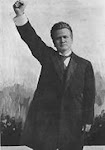Progress with the state budget is at a standoff in the
Capitol. Behind closed doors, leaders are talking details and trying to find
votes.
Openly, legislative leaders point to a lack of agreement on
public education. They say no progress can happen until they round up necessary
votes for the education portion of the budget. Privately, some GOP lawmakers
are also angling to spend money on a big change to business personal property
taxes. However, changes to taxes could take away money promised to schools.
Wisconsin pays for schools through an Equalized Aid formula,
which is meant to equalize resources to children no matter where they live in
the state. The idea of equal opportunity for children regardless of their zip
code is deeply rooted in our state. Principles enshrined in Wisconsin’s
Constitution include public education as a state function that is free with
reasonable equality of education opportunities for all children and without
excessive reliance on property taxes. Lawmakers must grapple with meeting those
principles.
Under the Governor’s proposal, school funding through
equalized aid would be lower in the 2018-19 school year than it was thirteen
years prior. The effect of these decisions will intensify the inequalities
schoolchildren across Wisconsin face.
Lawmakers admit the state’s way of funding schools is
broken. Nevertheless, legislative leaders appear poised to ignore the need to
change the formula. Instead, Governor Walker’s budget proposal increases state
money to local schools but allocates that aid outside the funding formula.
Thus, the wealthy suburban districts get the same amount of new money per
student as the poor rural or inner city districts. The Governor also proposed
adding to property tax credits, which lowers property taxes in a way that
benefits wealthier districts.
Recently, Assembly Republicans released their own
education-funding plan that lowers the Governor’s aid proposal and eliminates
any increases in Sparsity Aid, which is targeted at rural schools.
Wisconsin is changing and these changes are reflected in our
schoolchildren’s needs. Child poverty is rising. In a recent ten-year period,
poverty (measured by the federal definition of eligibility for free and reduced
lunch) more than doubled. The number of students with special education and
multi-lingual needs also increased. In addition, rising property values,
declining enrollment and low income in rural areas combine to create a crisis for
rural schools.
These realities make the argument for changes in our
equalized aid formula. State Superintendent of Schools Tony Evers recognized
these needs years ago and proposed new ways to pay for schools. State
legislative leaders rejected these changes and instead expanded state funded
private school programs.
Current school funding proposals add up to a future that is
increasingly unequal. Lawmakers must address the real problems facing today’s
children and teachers. We must ask the hard questions that underlie decisions
about money and schools. Should a child, born into a poor family, an inner-city
neighborhood or a rural country home, or born with a special need face fewer
opportunities in his or her public school?
More money in tax credits and the failure to acknowledge the
changing needs of our students creates a more unequal experience for children
around our state. This problem is solvable. But the path majority lawmakers
appear to be following takes us deeper into the woods of inequity.
Hanging in the balance is the answer to the question; will
future children across the state receive an equal education?
(A big thanks to Russ Kava, senior analyst with the
Legislative Fiscal Bureau and his colleagues for their recent papers related to
school budget decisions. This column used many details from their work. The
conclusions are mine).














No comments:
Post a Comment